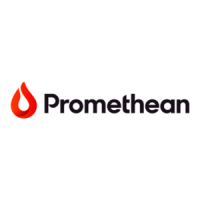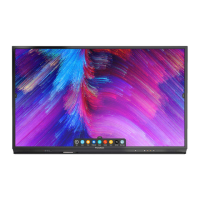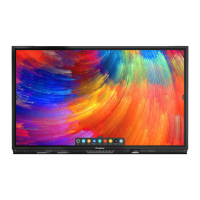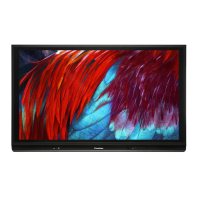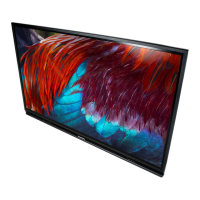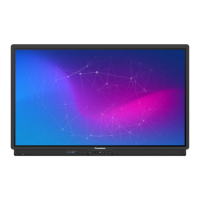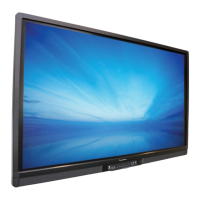Do you have a question about the promethean ActivPanel Titanium and is the answer not in the manual?
Describes the panel's purpose, seamless integration, and interactive learning experience for classrooms.
Details the ergonomic center console's positioning and accessibility for adjusting volume and menus.
Explains how to access the Unified Menu for quick access to essential tools like Whiteboard and Annotate.
Describes the Locker as a central location for accessing apps, tools, files, and settings.
Explains how dual proximity sensors enable quick power-on and how they can be managed or disabled.
Details the power button, volume adjustments, and Promethean Flame access to the Unified Menu.
Explains how to freeze the display and control touch input by turning touch on or off.
Describes the function of the source button for switching between connected devices.
Covers power, arrow navigation, selection, and volume adjustment using the remote.
Explains how to access the Unified Menu and switch between connected sources.
Details the blank screen function for privacy and the freeze function for static images.
Describes Back, Locker, User, and Home buttons for panel navigation and access.
Details access to Whiteboard, Capture, Annotate, Source, Screen Share, Recent Apps, and Help apps.
Accessing preinstalled Classroom Essential apps and any installed applications.
Changing panel settings such as brightness, volume, and accessing more configurations.
Viewing device information, useful for IT administrators or support.
Instructions to access brightness settings via the Unified Menu, Locker, and gear icon.
Instructions to access volume settings via the Unified Menu, Locker, and gear icon.
Steps to activate Palm Reject via the Unified Menu, Locker, and gear icon for touch input.
Instructions to activate Large Mode via Unified Menu, Locker, and gear icon for larger icons.
Accessing network, app information, and user profile management settings.
Customizing screen brightness, volume, and system configurations.
Managing screen lock options and location services.
Steps for connecting via Ethernet cable or wireless network.
Instructions to toggle panel speakers on or off through the settings menu.
Steps to change the ActivPanel's home screen wallpaper via Display settings.
Docking windows to the left or right side of the screen for multitasking.
Entering fullscreen mode or hiding the application from view.
Resizing windows using the sizing handle and closing applications.
Process for creating new user profiles and initial setup.
Switching between user accounts and managing profile settings.
Creating a PIN or password for user profile security.
Process for logging in and out of user profiles with security enabled.
Changing or removing the PIN or password for profile security.
Accessing and signing out of the guest profile for temporary users.
Steps to connect and authorize Google Drive access on the ActivPanel.
Using the Files app and Google Drive to access and save files.
Steps to connect and authorize Microsoft OneDrive access on the ActivPanel.
Using the Files app and OneDrive to access and save files.
How to open the Whiteboard app and utilize its toolbar for drawing and annotation.
Using the Capture app to take screenshots and crop images for lessons.
Using Pen, Highlighter, Eraser, Undo/Redo tools for real-time annotations.
Accessing connected devices via the Unified Menu or Center Console.
Setting which input source automatically launches when the panel powers on.
Using Clock, Timer, Stopwatch modes, presets, and multiple timers.
Using full screen, floating, or condensed modes and creating/editing lists.
Creating an account and accessing the Resource Library for flipcharts.
Exploring tutorials, courses, and resources available on the Learn Promethean website.
Connecting devices using the Sender app, Chrome Extension, or mobile app.
Entering Panel ID and name, and enabling Touchback on the sender.
Connecting via Chrome extension or mobile app as a guest or signed-in user.
Viewing connected devices, selecting students, and initiating screen sharing.
Understanding Touchback indicators, removing students, and sorting the waiting room.
Adjusting quality settings, refreshing the Panel ID, and closing the session.
Alternative method for in-classroom connection using native Wi-Fi Direct.
How students enable Touchback and visual indicators like the green dot.
Loading activities from USB and navigating the player interface.
Opening and running multiple activities simultaneously for collaborative learning.
Finding and switching between recently used applications on the panel.
Tapping the 'x' icon to close individual applications from the recent apps list.
Navigating to the app management section within the panel's settings.
Inspecting details such as permissions, storage, and data usage for installed apps.
Finding and accessing installed applications via the Locker interface.
Rearranging application icons within the Locker for personalized quick access.
Organizing apps into new pages by dragging icons to create custom layouts.
Closing applications by accessing the Recent Apps menu and tapping the close icon.
Steps to uninstall applications from the panel via the settings menu.
Connecting a USB drive and viewing its contents through the Files app.
Downloading selected files from the USB drive to the ActivPanel.
Adding websites to bookmarks, editing, organizing them into folders, and deleting.
Using VGA, HDMI for video and USB for touch input when connecting a laptop.
Locating the accessible USB, HDMI, and Touch ports on the front of the panel.
Identifying all available connection ports located on the back of the panel.
How to select and change input sources using the Unified Menu or Center Console.
Physical installation, firmware updates, and network configuration for OPS-G.
Accessing the ActivConnect OPS-G device via the Source menu.
Linking the OPS-G to the ActivPanel by registering its serial number.
Connecting the Chromebox using HDMI 2 and USB 2 ports.
Initial setup including power, Google account, and source selection.
Contacting support via website, Twitter, and YouTube channel.
Accessing tutorials, courses, and resources for enhancing expertise.
On-panel assistance including videos, tutorials, and contacting support.
Describes the panel's purpose, seamless integration, and interactive learning experience for classrooms.
Details the ergonomic center console's positioning and accessibility for adjusting volume and menus.
Explains how to access the Unified Menu for quick access to essential tools like Whiteboard and Annotate.
Describes the Locker as a central location for accessing apps, tools, files, and settings.
Explains how dual proximity sensors enable quick power-on and how they can be managed or disabled.
Details the power button, volume adjustments, and Promethean Flame access to the Unified Menu.
Explains how to freeze the display and control touch input by turning touch on or off.
Describes the function of the source button for switching between connected devices.
Covers power, arrow navigation, selection, and volume adjustment using the remote.
Explains how to access the Unified Menu and switch between connected sources.
Details the blank screen function for privacy and the freeze function for static images.
Describes Back, Locker, User, and Home buttons for panel navigation and access.
Details access to Whiteboard, Capture, Annotate, Source, Screen Share, Recent Apps, and Help apps.
Accessing preinstalled Classroom Essential apps and any installed applications.
Changing panel settings such as brightness, volume, and accessing more configurations.
Viewing device information, useful for IT administrators or support.
Instructions to access brightness settings via the Unified Menu, Locker, and gear icon.
Instructions to access volume settings via the Unified Menu, Locker, and gear icon.
Steps to activate Palm Reject via the Unified Menu, Locker, and gear icon for touch input.
Instructions to activate Large Mode via Unified Menu, Locker, and gear icon for larger icons.
Accessing network, app information, and user profile management settings.
Customizing screen brightness, volume, and system configurations.
Managing screen lock options and location services.
Steps for connecting via Ethernet cable or wireless network.
Instructions to toggle panel speakers on or off through the settings menu.
Steps to change the ActivPanel's home screen wallpaper via Display settings.
Docking windows to the left or right side of the screen for multitasking.
Entering fullscreen mode or hiding the application from view.
Resizing windows using the sizing handle and closing applications.
Process for creating new user profiles and initial setup.
Switching between user accounts and managing profile settings.
Creating a PIN or password for user profile security.
Process for logging in and out of user profiles with security enabled.
Changing or removing the PIN or password for profile security.
Accessing and signing out of the guest profile for temporary users.
Steps to connect and authorize Google Drive access on the ActivPanel.
Using the Files app and Google Drive to access and save files.
Steps to connect and authorize Microsoft OneDrive access on the ActivPanel.
Using the Files app and OneDrive to access and save files.
How to open the Whiteboard app and utilize its toolbar for drawing and annotation.
Using the Capture app to take screenshots and crop images for lessons.
Using Pen, Highlighter, Eraser, Undo/Redo tools for real-time annotations.
Accessing connected devices via the Unified Menu or Center Console.
Setting which input source automatically launches when the panel powers on.
Using Clock, Timer, Stopwatch modes, presets, and multiple timers.
Using full screen, floating, or condensed modes and creating/editing lists.
Creating an account and accessing the Resource Library for flipcharts.
Exploring tutorials, courses, and resources available on the Learn Promethean website.
Connecting devices using the Sender app, Chrome Extension, or mobile app.
Entering Panel ID and name, and enabling Touchback on the sender.
Connecting via Chrome extension or mobile app as a guest or signed-in user.
Viewing connected devices, selecting students, and initiating screen sharing.
Understanding Touchback indicators, removing students, and sorting the waiting room.
Adjusting quality settings, refreshing the Panel ID, and closing the session.
Alternative method for in-classroom connection using native Wi-Fi Direct.
How students enable Touchback and visual indicators like the green dot.
Loading activities from USB and navigating the player interface.
Opening and running multiple activities simultaneously for collaborative learning.
Finding and switching between recently used applications on the panel.
Tapping the 'x' icon to close individual applications from the recent apps list.
Navigating to the app management section within the panel's settings.
Inspecting details such as permissions, storage, and data usage for installed apps.
Finding and accessing installed applications via the Locker interface.
Rearranging application icons within the Locker for personalized quick access.
Organizing apps into new pages by dragging icons to create custom layouts.
Closing applications by accessing the Recent Apps menu and tapping the close icon.
Steps to uninstall applications from the panel via the settings menu.
Connecting a USB drive and viewing its contents through the Files app.
Downloading selected files from the USB drive to the ActivPanel.
Adding websites to bookmarks, editing, organizing them into folders, and deleting.
Using VGA, HDMI for video and USB for touch input when connecting a laptop.
Locating the accessible USB, HDMI, and Touch ports on the front of the panel.
Identifying all available connection ports located on the back of the panel.
How to select and change input sources using the Unified Menu or Center Console.
Physical installation, firmware updates, and network configuration for OPS-G.
Accessing the ActivConnect OPS-G device via the Source menu.
Linking the OPS-G to the ActivPanel by registering its serial number.
Connecting the Chromebox using HDMI 2 and USB 2 ports.
Initial setup including power, Google account, and source selection.
Contacting support via website, Twitter, and YouTube channel.
Accessing tutorials, courses, and resources for enhancing expertise.
On-panel assistance including videos, tutorials, and contacting support.
| Brand | promethean |
|---|---|
| Model | ActivPanel Titanium |
| Category | Monitor |
| Language | English |


